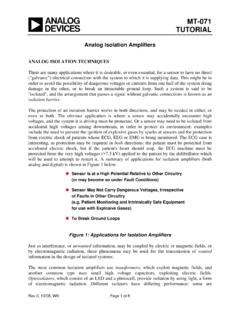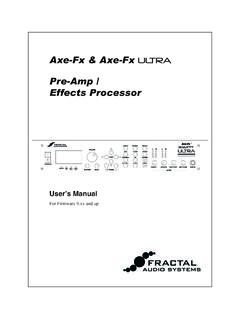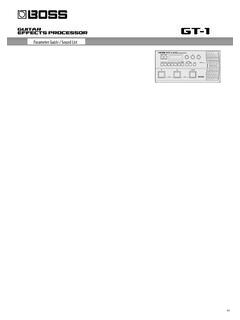Transcription of RTL-SDR Blog V3 Datasheet
1 RTL-SDR Blog V3 Datasheet The RTL-SDR Blog V3 is an improved RTL-SDR dongle. RTL-SDR dongles were originally designed for DVB-T HDTV reception, but they were found by hardware hackers to be useful as a general purpose SDR. The standard dongles are okay for DVB-T reception, but are just barely suitable for SDR users/experimenters. The RTL-SDR Blog V3 was redesigned with SDR user needs in mind, instead of DVB-T HDTV users who typically have more relaxed requirements. Purchase at: Quickstart setup guide available at: Basic Information Bandwidth: Up to MHz stable. ADC: RTL2832U 8-bits Frequency Range: 500 kHz 1766 MHz (500 kHz 24 MHz in direct sampling mode) Typical Input Impedance: 50 Ohms Typical Current Draw: 270 280 mA Required Computing Hardware Same requirements as a regular RTL-SDR .
2 Compatible with Windows XP and above (SDR# requires Win 7 or newer), Linux, MacOS and Android. A dual core machine is recommended. Single board PCs like the Raspberry Pi, Odroid, are also supported with most command line apps. RTL-SDR V3 Improvements over generic models TCXO The V3 uses a 1 PPM TCXO for excellent frequency stability. The temperature drift is around 1 PPM, and the initial offset is 0 2 PPM. This means that the signal will not drift on the spectrum as the dongle or ambient temperature changes. Also, the frequency offset will be close to zero. Standard dongles have a PPM offset of up to 100 PPM, and tend to drift a lot.
3 Using a TCXO solves these problems. SMA Connector Typical RTL-SDR dongles use a relatively obscure MCX RF connector. The V3 uses commonly used SMA connectors, so it is easy to obtain adapters, connectors and antennas for the unit. SMA connectors also last longer. Aluminium Enclosure Unlike standard RTL-SDR s, the V3 comes standard with an aluminium enclosure. The enclosure has two purposes. The first is to help block any RF interference from entering through the PCB. The second is to act as a heatsink to the PCB. Improved Heat Dissipation Typical R820T/2 RTL-SDR dongles tend to lose PLL lock in L-band at around GHz and above, causing a loss of reception to those frequencies.
4 The reason is due to the high heat generated by the R820T2 chip. The V3 uses a thin thermal pad to thermally bond the PCB and metal enclosure together. This allows the metal case to work as a heat sink, which solves the PLL lock problem. Ideally the thermal pad should be as thin as possible to enhance maximum heat transfer, and we have designed the enclosure so that the thermal pad only needs to be 3mm thick. The V3 also uses a larger ground plane on the middle layers of the PCB which also helps with heat dissipation. R820T2 Chip Older RTL-SDR units used the R820T chip. There is a newer R820T2 which has slightly better manufacturing tolerances.
5 The R820T2 is produced in a factory with higher quality silicon which allows for more reliable chips. A side effect of the better silicon is overall slightly better and more stable sensitivity across manufacturing runs compared to the R820T, and less PLL lock problems at L-band frequencies. Improved ESD protection on the RF front end The BAV99 diode which is used on most RTL-SDR dongles is not a true ESD rated diode. We have added a real ESD rated diode for better protection. The BAV99 remains in the circuit as it works a strong signal clipper, which prevents damage to the R820T2 from overly strong signals. Please remember that not even this will save your radio from a lightning strike or huge ESD impulse, and any permanently outdoor mounted antenna system must have its own lightning and ESD protection.
6 To help avoid lightning damage unplug your antenna during a storm and when the dongle is not in use. Improved front end circuit The standard matching circuit on the RTL-SDR was designed for DVB-T use, and tends to attenuate signals above ~1 GHz. The new matching circuit has less attenuation above 1 GHz and similar performance below. We have used high quality, high SRF, high Q inductors in this circuit. Software switchable bias tee. The V3 makes use of a low noise LDO and one of the GPIO pins on the RTL2832U to provide a bias tee that can be activated in software. The bias tee can pull about 180 mA continuously so is suitable for the majority of 3-5V powered LNAs that are popular with RTL-SDR devices.
7 The bias tee is protected against accidental short circuits at the LDO level, and with a thermal auto-resetting PTC fuse. See Activating the Bias Tee for more information on software for activating the bias tee. This bias tee is great for powering a remote LNA (like Adams PSA5043+ based LNA4 ALL) or something like the SpyVerter upconverter. Bias Tee Warning: The bias tee thermal fuse or LDO could be damaged if you short circuit the bias tee for long periods of time. Before turning on the bias tee, ensure the circuit to be powered is not shorted, or that the RTL-SDR is not connected to a DC shorted antenna! Lower Voltage Operation The V3 uses an LDO that has a much lower dropout voltage compared to the typical AMS1117 LDO used on most dongles.
8 Hence the V3 should run better on long USB extension cables. Long USB cables tend to drop the 5V USB voltage down to lower levels. Below about 4V the AMS1117 stops working. The LDO used in the V3 works almost down to Of course, with low voltages from long USB cable, the bias tee will be unable to put out At low voltages the bias tee LDO will revert to a non-filtered voltage slightly under the supply. Reduced noise with a modified PCB design Typical RTL-SDR dongles use 2-layer PCB designs and route signal lines improperly. The V3 uses a modified 4-layer PCB design which helps to significantly reduces clock spurs and noise pickup.
9 The V3 also adds a USB common mode choke on the USB data lines to reduce USB noise, adds SMD ferrite chokes on the PCB power lines, and uses a lower noise LDO. HF direct sampling circuit, diplexed out from the SMA connector The idea behind direct sampling mode is that an antenna can be connected directly to the ADC pins of the RTL2832U, and this can enable HF reception. This is useful because the R820T/2 tuner can only tune down to about 24 MHz at the lowest. On typical R820T RTL-SDR dongles one can enable direct sampling mode by soldering a wire to the Q-branch pins of the RTL2832U. The RTL2832U samples at MHz, so 0 MHz, and MHz MHz can be listened to.
10 The V3 has direct sampling mode implemented in hardware already, so no hardware mods are required to listen to HF via direct sampling. To split the HF signal out at the SMA connector, a diplexer tuned to 25 MHz is used. A 10dB buffer preamp sits after the diplexer which helps to boost the signal and overcome losses in the subsequent filter and impedance transformer. After the preamp is a 24 MHz low pass filter and then an impedance matching and single to double ended transformer. The addition of the preamp, filter and transformer ensures good direct sampling performance . The result is that 500 kHz to about 24 MHz can be received in direct sampling mode.



